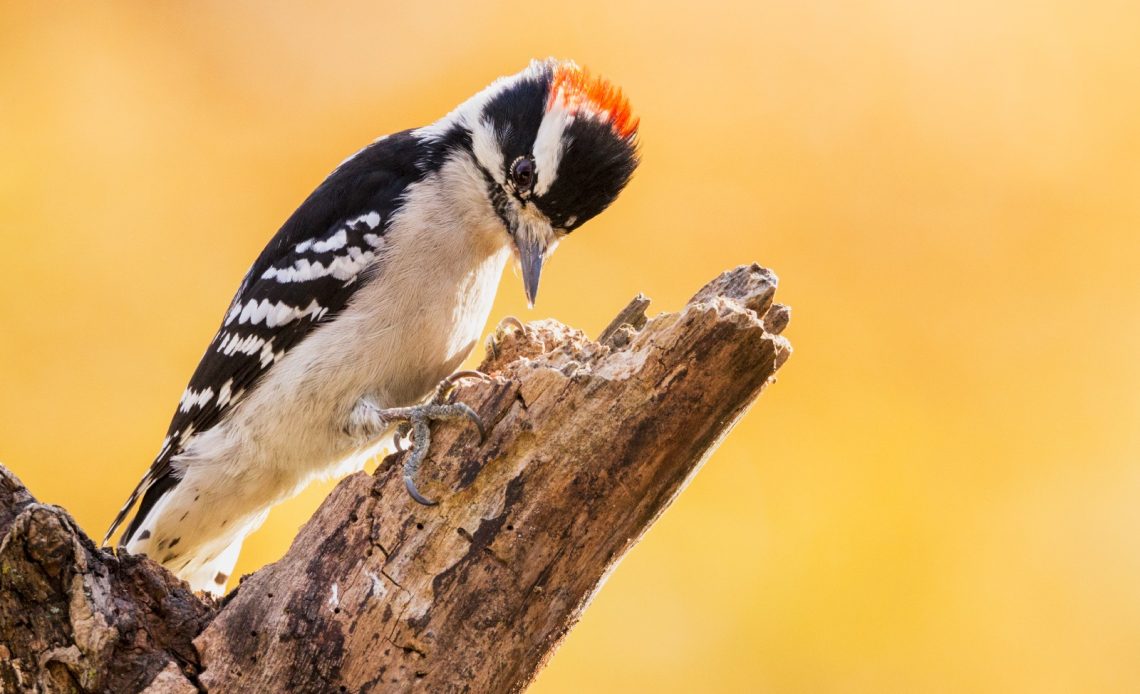

We’re here to help! Wild Yards is a completely free website that is 100% dedicated to helping you create a wildlife-friendly, sustainable yard. Read more
WildYards is reader-supported. When you buy a product through a link on our site, we may earn a comission. Every product is independently selected by our (obsessive) editors and our reviews are unbiased and objective. Read more about our mission or our privacy policy.
Woodpeckers are easily some of the most fascinating birds we can find in our gardens. You can spot various woodpecker species across the US, each with its own plumage and markings. They also have fascinating lifestyles and behaviors – for example, what do woodpeckers eat?
Woodpeckers have varied diets, gaining nutrition from insects, seeds, nuts, berries, and various organic matter. Although insects are considered the most important part of a woodpecker’s diet, they need the nutrients from all food groups, many of which will likely already be in your garden!
14 Things Woodpeckers Eat
Woodpeckers are famously voracious birds and are omnivorous – meaning they will partake in vegetation and meat to keep active and healthy. It’s a common misconception that these birds will only eat nuts and bugs – as you’ll see below, there are various snacks you can leave out to help attract woodpeckers and keep them well-fed across the seasons. Here’s what your woodpecker visitors will want to munch on the most.
Insects
It is believed that about 75% of a woodpecker’s diet is insects – this is largely thanks to their high protein content, which woodpeckers need to keep drilling throughout the day.
Woodpeckers particularly enjoy insects that can be found in the wood they drill and drum, such as beetles, grubs, and spiders.
Curiously, woodpeckers seem to particularly enjoy feasting on ants, or more specifically, carpenter ants. It’s thought that woodpeckers eat ants more than any other bird. It is estimated that there are over a quadrillion ants in the world, with over 1,000 species living right here in the US. There’s always going to be a ready supply of ‘fast food’ for your local peckers to get into.
In some cases, woodpeckers can prove useful in helping to rid gardens of so-called ‘pests’ – some species, such as the downy woodpecker, will even munch through mosquitoes. It may be worth attracting woodpeckers to your yard instead of relying on harmful chemicals and pesticides.
Protein from insects is vital to help protect the average woodpecker from suffering injuries. Incredibly tough skulls and muscle networks cushion their brains to help protect against damage.
It is estimated that woodpeckers peck their beaks about 12,000 times per day! Given how much impact their heads go through every day, woodpeckers desperately need to keep their brains safe, which is where the much-needed protein comes in – it’s perfect for building and maintaining healthy muscle.
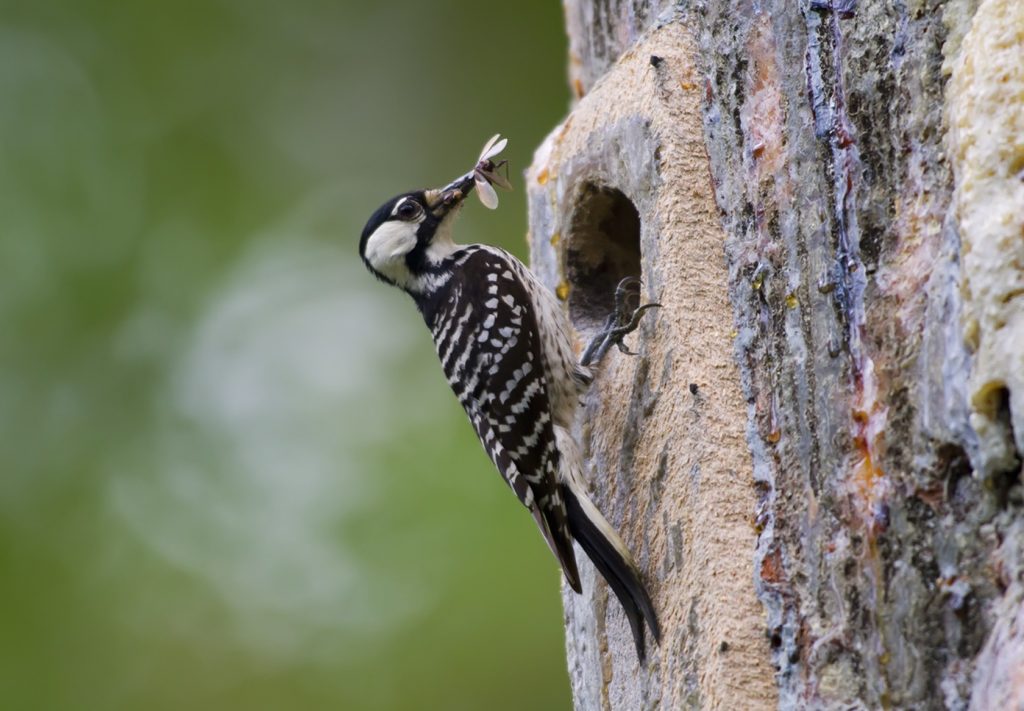
Termites
Wood-dwelling termites provide a frequent source of protein for most woodpeckers to feed on in a pinch. Woodpeckers love eating termites in part because they are so ubiquitous. Termites predominantly eat in tree stumps and decaying trees. And, eating through them makes the woodpeckers’ job that much easier. Since the wood is more hollow and brittle, the woodpeckers do not have to drum the tree so hard with their beaks to get inside.
There’s also the fact that where you find one termite, you typically find plenty of others. Termites reproduce wildly, so when a woodpecker lands on a nest of them, it’s pretty much an all-you-can-eat buffet.
Termites, like other garden insects, are rich in protein – meaning any given woodpecker drilling away at a dead tree will likely find a hidden cache of vital nutrients.
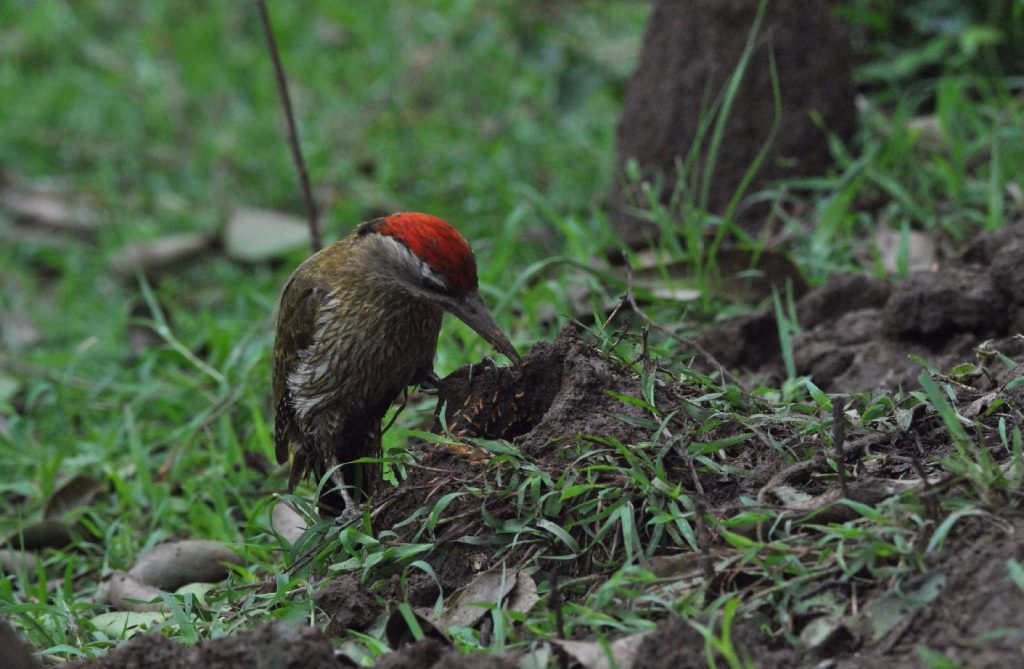
Bees
Sad but true – bees sometimes fall prey to woodpeckers as they’re fairly slow to catch.
These careful pollinators take their time to delicately feed from flowers across the garden – and unlike flies, bees are fairly easy to catch, making them ideal prey for woodpeckers. Much like termites, bees are packed in protein, though the average woodpecker may get a sting or two if they feed on them constantly.
Some bees can even be found in trees. They make their way through the bark via tunnels, thus damaging the bark. By retrieving them from the trees to eat them, woodpeckers are inadvertently helping plants.
That said, bees of various species are dwindling in numbers. If you are concerned that woodpeckers might be going after a hive in your garden, it’s a good idea to contact your local wildlife authority, who can advise on how to safely move the hive on.
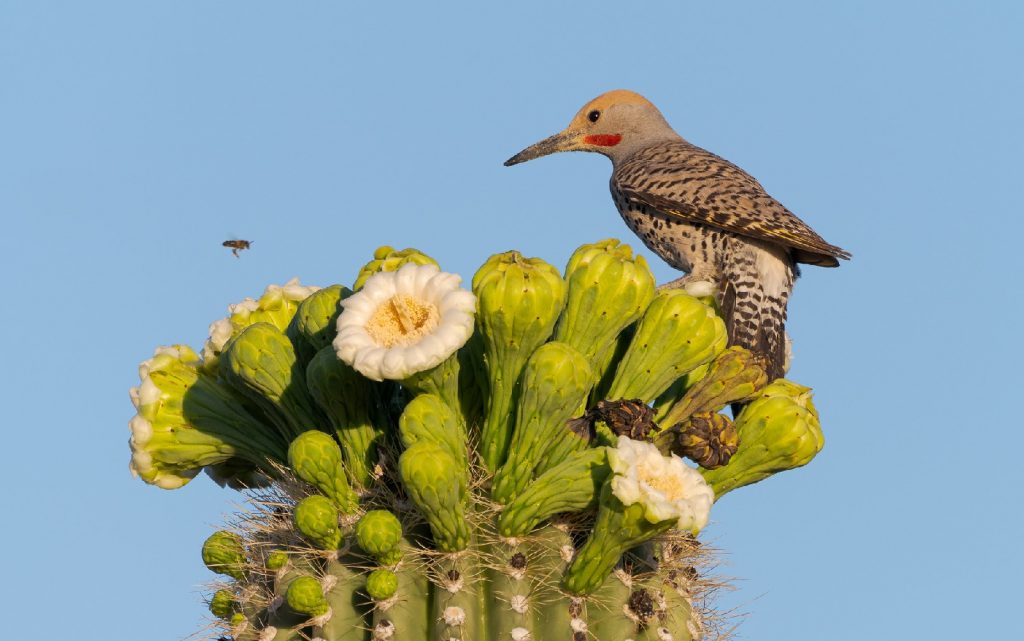
Larvae
Woodpeckers often feed on larvae because they’re packed full of protein, and are very easy to catch. Many species enjoy wood-boring larvae, such as beetle larvae or mealworms.
Much like termites and some species of bee, wood-boring insects tend to damage trees to the point of rotting. Once again, woodpeckers prove to be highly useful in protecting some of our much-loved plants and growths.
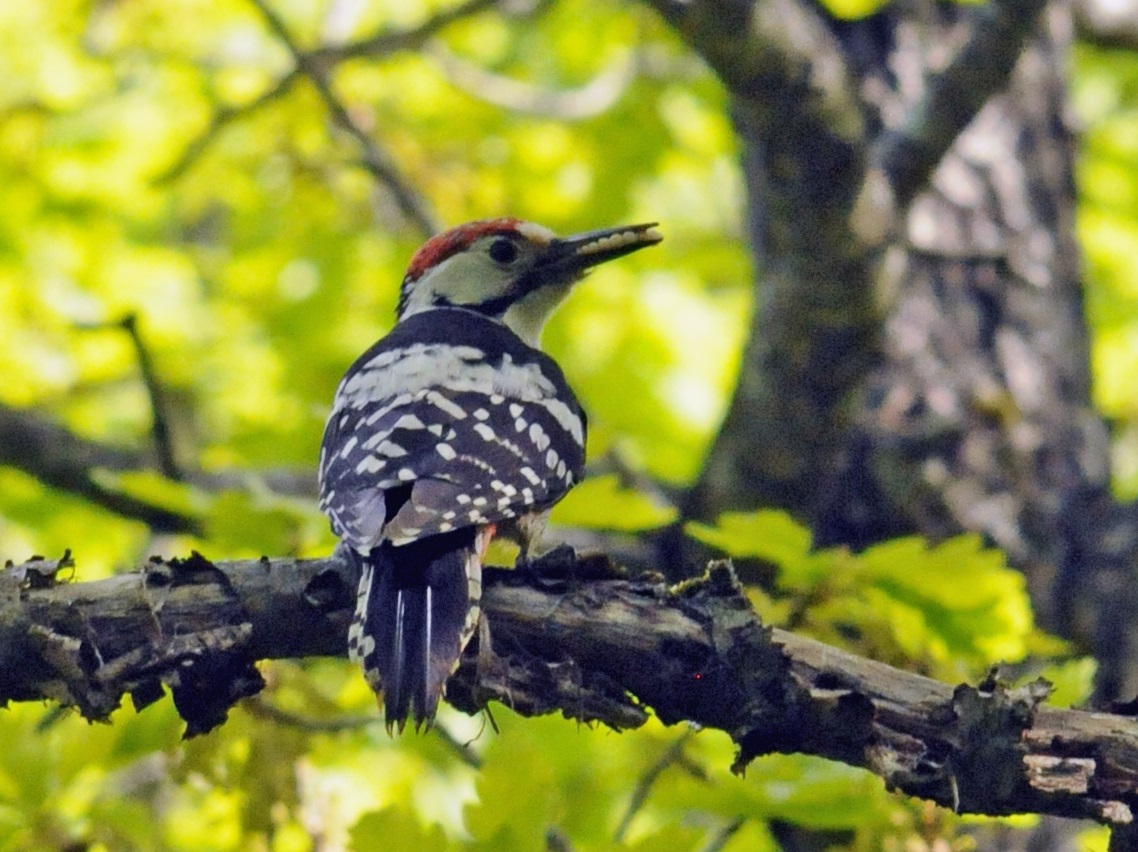
Bird Seed
Like most birds with hard beaks, woodpeckers will happily eat away at seed you leave in a feeder, or on a table. But, if you really want to please a woodpecker, then you’ll have to do more than just ‘regular’ bird seed from the pet store.
Black oil sunflower seeds, for example, are ideal for woodpeckers as they are full of protein – great for helping to provide these birds with the energy they need to drum and drill throughout the day. They also contain abundant healthy fats, vitamin B, and calcium.
While sunflower seeds are high on the list of woodpecker favorites, they will also attract an abundance of different birds, such as goldfinches and songbirds. At the very least, if you already house chickens, they’ll help by pecking away at any you dare to spill.
To help the woodpeckers out, place a specific feeder for them in a quiet part of your garden, preferably with a perch. This will help to cut down any intrusion from other seed-hungry birds.
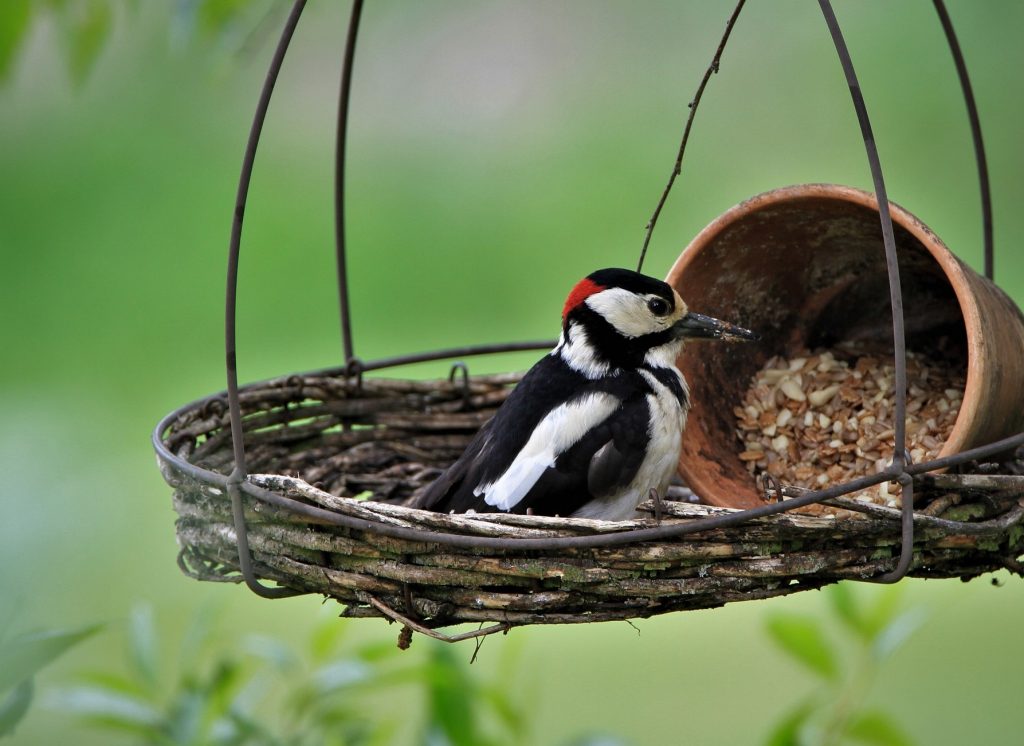
Acorns
Acorn woodpeckers, aptly named, are perhaps the most famous oak tree feeders, though most species will feast on these nuts if they’ve available.
Acorn woodpeckers are highly resourceful birds that actively hunt and store acorns, particularly in the fall as they start to stock up for winter. These nuts make for ideal woodpecker snacks as they are crammed full of energy and protein.
Oak trees are usually overflowing with these protein and calorie-filled little wonders, which means they should never have to go without acorns for too long if they find a shaded spot. Planting an oak tree is a great idea if you want to attract woodpeckers – and you don’t have to worry about these birds destroying the plant itself – they just want the nuts.
Due to interest in acorns from other roving wildlife – especially from sneaky squirrels – it’s best to invest in a squirrel-proof feeder. Available online and in pet stores, these feeders are designed to give peckers access to these tasty treats without having to worry about losing out to the bushy-tailed bandits!
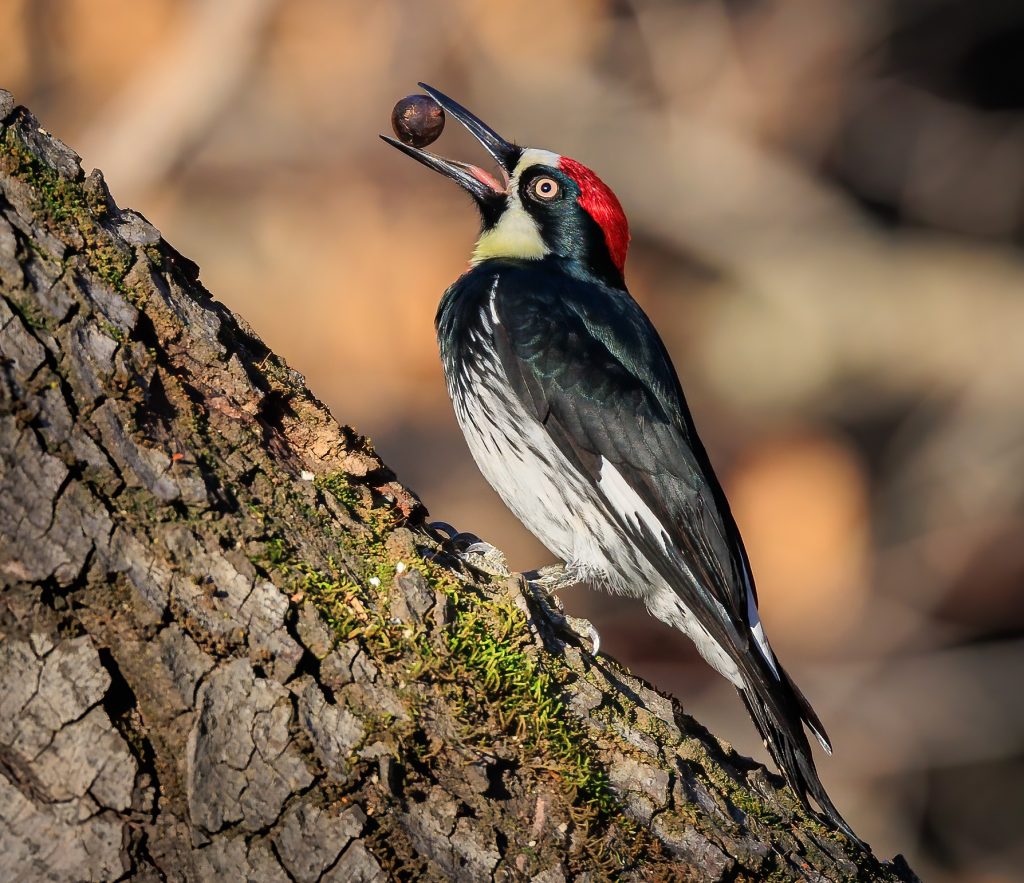
Peanuts
Peanuts are great for woodpeckers as they are full of protein and fats. In areas where food is a little scarce, or when the cold is starting to set in, peanuts stored in the hollows of decaying trees can be real life-savers for woodpeckers. By eating and digesting these treats, woodpeckers feel fuller for longer and will benefit from slow energy release.
Peanuts will do more than just attract woodpeckers. They are excellent sources of food for other birds such as grackles, cardinals, and doves – so, as with seed and acorns, be sure to set up a separate woodpecker feeder away from the hustle and bustle of your garden’s hotspots.
You may even find some four-legged creatures, such as deer, showing interest in peanuts that may get scattered around your yard – if it’s birds that you’re trying to attract, remember to keep nuts stored up high.
You could even take a pine cone rolled in peanut butter, then roll it again in peanuts and hang it in a tree for your woodpeckers to find – providing a superb makeshift snack machine.
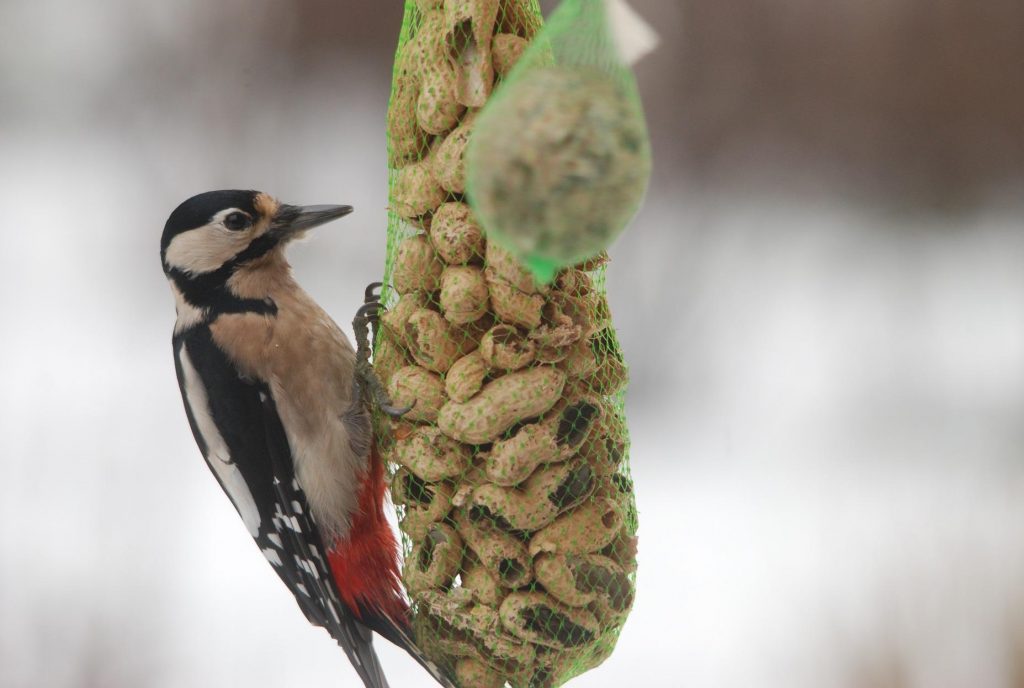
Suet
Thanks to being crammed full of fat and protein, suet is perhaps the woodpecker’s favorite food – and it’s one that you’ll have to provide to them.
Suet is made from hard fat found around the kidneys and loins of cattle and sheep – it’s widely available to purchase from local butchers and pet stores.
As a pure form of animal fat, suet is fantastic for keeping woodpeckers feeling full and energized. It also happens to be very easy for them to digest, making it that much more appealing.
Although it’s nigh-on impossible for woodpeckers to come across suet naturally, they usually eat it in abundance when gardeners place it in suet feeders for woodpeckers to find. Even better is that many other species won’t compete for this superfood – it’s an exclusive feast for your local woodpeckers.
Suet is particularly helpful for woodpecker diets in the fall and winter. As temperatures start to drop, they’ll need plenty of fatty foods to keep them insulated during the cold.
It is best only to feed suet to the woodpeckers when it’s cold outside, as it’ll normally go bad quickly in warm weather. Not only will it attract all kinds of flies, pests, and other less-appealing creatures, but it will also be less appealing for your local birds – and may even cause a stink in your garden!
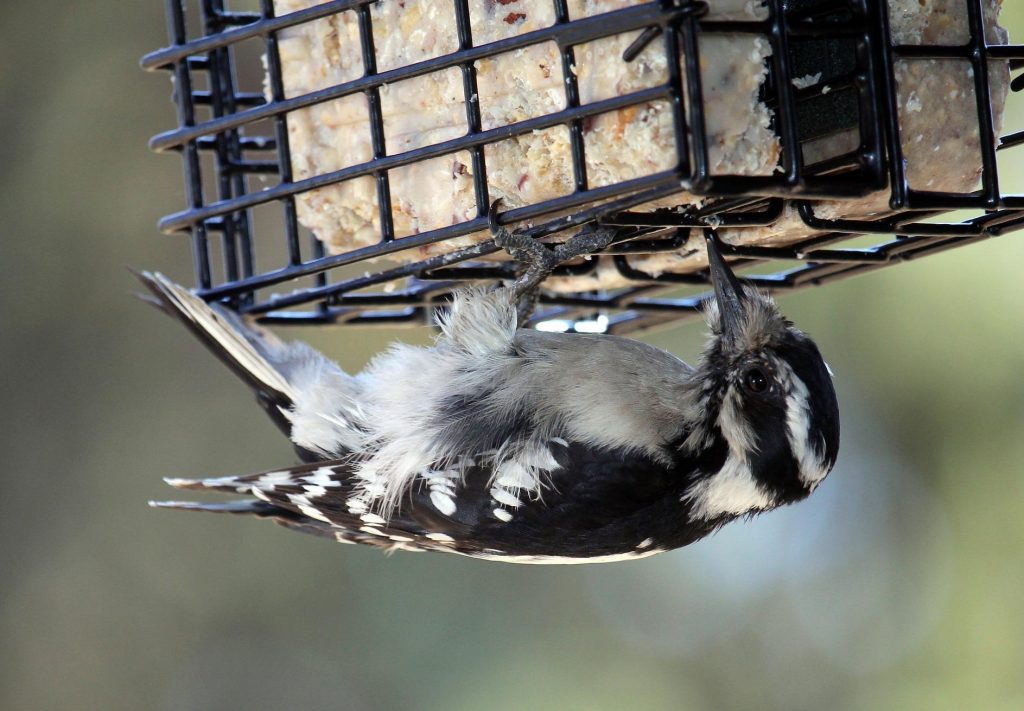
Nectar
Hummingbirds are not our only flying friends to love nectar – woodpeckers readily eat it too, albeit in quite a different way.
Unlike hummingbirds, woodpeckers will not fly around from flower to flower, searching to suck out as much nectar from plants as possible. Instead, they are quite happy to drink artificial nectar we leave out in our hummingbird feeders. It’s a key reason why it’s important to separate woodpecker and hummingbird feeders in the same garden.
Hummingbird feeders are specifically designed with tiny openings to perfectly suit their beaks or even a butterfly’s proboscis. Despite this, woodpeckers have secret weapons to help them unlock such sugary vaults.
Woodpecker tongues can stretch out up to two feet past their beaks – and are just thin enough to get into most hummingbird feeders. If you really want to save hummingbird nectar for the hummers alone, make sure you have a woodpecker table and feeder set up with more interesting snacks (such as those listed above).
Despite their propensity to steal artificial nectar from hummingbirds, sugar water can be good for woodpeckers, too. Given the high-sugar content, nectar can help to keep the woodpeckers energized and hydrated.
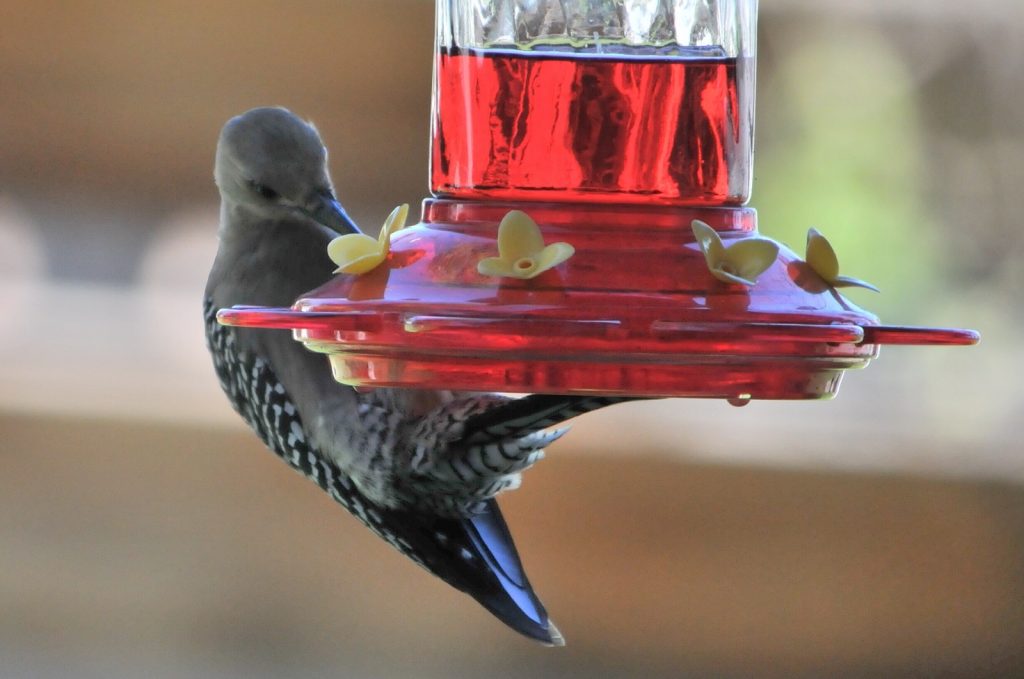
Berries
Woodpeckers are firm fans of all kinds of sweet fruit, such as strawberries, blackberries, blueberries, cherries, and more. Most berries grow abundantly in woody areas, which makes them relatively easy for woodpeckers to come by.
Their sugar content, in particular, seems to be what attracts woodpeckers the most, as is the case with manufactured nectar. They provide quick, sweet hits of energy that are easy to digest. While woodpeckers typically won’t hunt down berries and other fruit (they can’t store them like acorns and other nuts, for example), it’s rare they will pass up a snack.
The red-bellied woodpecker is, in particular, more partial to chowing down on berries and fruit than flying bugs – though they will still need to chow down on a few to keep healthy and active.
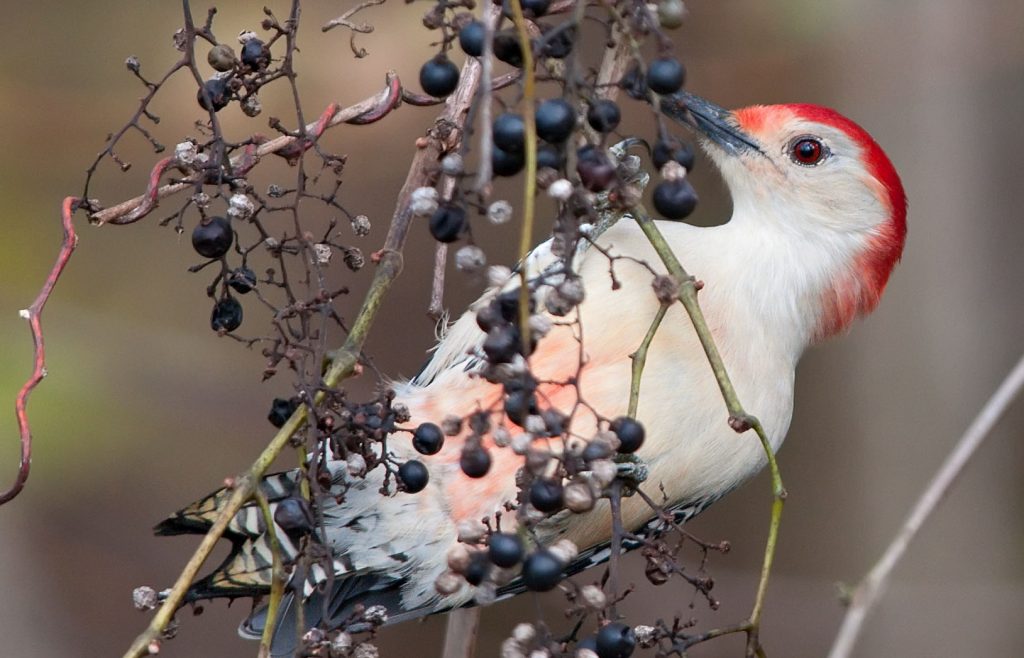
Tree sap
Tree sap doesn’t tend to be a favorite of most woodpeckers, but they will all eat it when they have to. It’s easy to eat, digest, and provides a high boost of energy thanks to its pure sugar content.
However, if you happen to be a woodpecker aficionado, then you’ll know that there’s a particular lineage that will actively seek out tree sap. They, of course, are known as sapsuckers.
While most woodpeckers are known for making holes in dead and decaying trees, sapsuckers need live ones to eat from. They can spend days drilling and getting nourishment from the same holes, and when the holes run out, they’ll simply make more.
Sapsuckers are most commonly found in the northeast of the US, and are also the only woodpeckers that will actively damage trees. It’s rare that you’ll need to worry about common woodpeckers damaging your trees, as many will simply rely on pre-drilled holes to drink from – this is common for hummingbirds, too, who may be desperate for nectar.
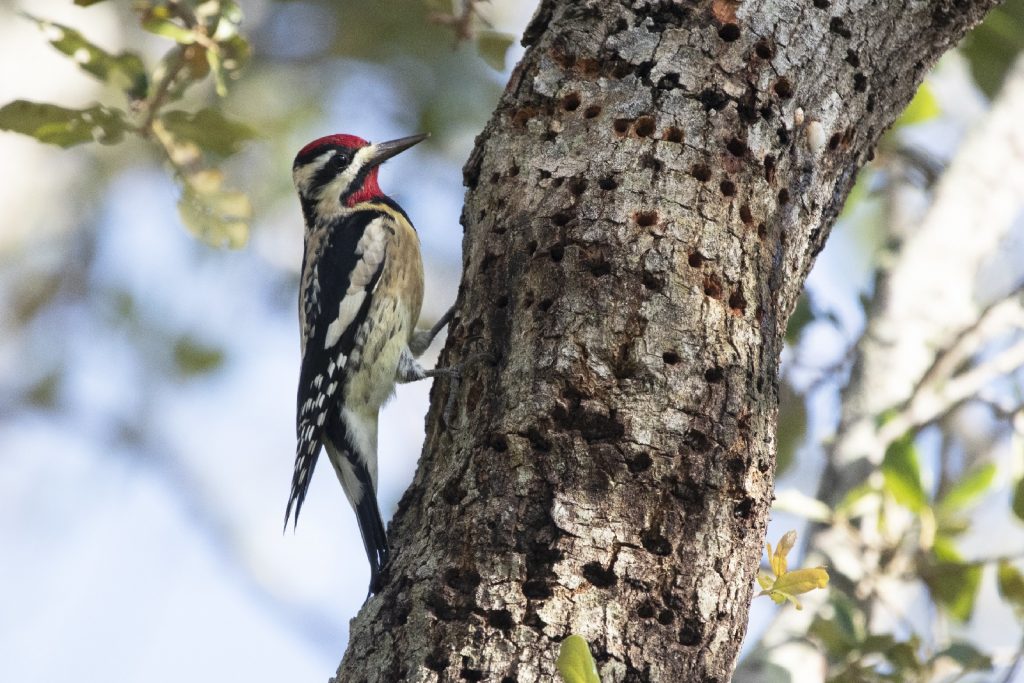
Other birds
In conditions where food is scarce, some species of woodpecker will attack and eat other birds – it is an act of hunger and desperation.
For example, red-headed and red-bellied woodpeckers are particularly known for foraging and eating the eggs from other birds’ nests. Bird eggs are packed with protein and are easy to access when left unattended, making them an ideal, unattended snack.
It’s unlikely that woodpeckers will feel the need to pilfer from nearby nests if they have a rich source of insects, sugar, and nuts elsewhere in their local habitat. Keeping these fascinating birds fed can be very important for the survival of other avians.
Fish
While rare, some woodpeckers will happily fish for their food if they need to. Fish are packed with healthy fats, oils, and protein, and in some cases, can be very easy to catch.
Although woodpeckers will not go deep-sea diving for their fishy treats, they will happily pluck smaller specimens out of shallow water – such as ponds, rivers, and shallow lakes. You likely won’t have to worry about woodpeckers clearing out your koi pond – and it’s not normally worth leaving fish out in their feeders.
Frogs and lizards
Like fish, smaller lizards and tree frog species can make rare prey for woodpeckers, but if they are hungry enough and an opportunity arises, both can be quite easy to catch. They’re extremely easy to digest, and much like insects, arrive packed with protein to keep woodpeckers drumming.
Although the average woodpecker has to pay attention to find them, they occasionally get lucky and spot these little exotic creatures roaming about their woody areas.
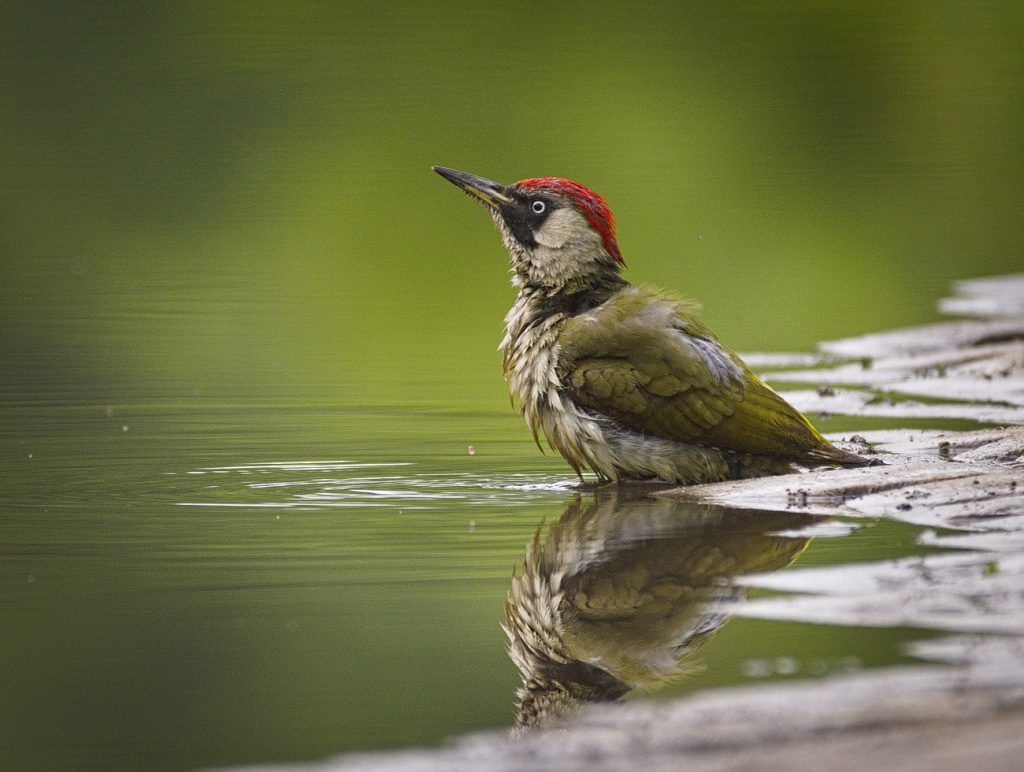
Wait… don’t woodpeckers eat wood?
No – it’s a common misconception that woodpeckers eat wood. It holds absolutely no nutritional value for them. They’ll happily eat the sap, but the bark itself is merely the cloche covering their gourmet meal.
You may find some woodpeckers with their beaks deep into the wood and even carrying it in their mouths – they are most likely building nests, and won’t eat wood even if they’re desperate to feed.
Do woodpecker diets vary much by species?
Generally speaking, woodpecker diets do not differ too much between species. They all need daily protein, fat, vitamins, and minerals. The main difference is that some simply prefer their plant-based foods, while others are keener on insects!
For example, downy woodpeckers are known for chowing down on peanuts! Whether it’s fresh shells or peanut butter in a feeder, these birds certainly go ‘nuts’ – and they’re known for thriving on sunflower seeds and millet, too.
Red-bellied woodpeckers, meanwhile, are the real herbivores among species. Although they do eat insects out of necessity, they are more often seen eating seeds, fruits, and nuts.
On the other hand, hairy woodpeckers are big protein birds! They love eating beetles, bees, spiders, ants, and termites.
Most woodpeckers are opportunistic eaters. They will eat what they have access to. Much like us, their diets change based on the seasons and the areas they nest in. The fact that they are omnivorous means that no matter the species of woodpecker, they will all be able to find foods that they can eat and digest.
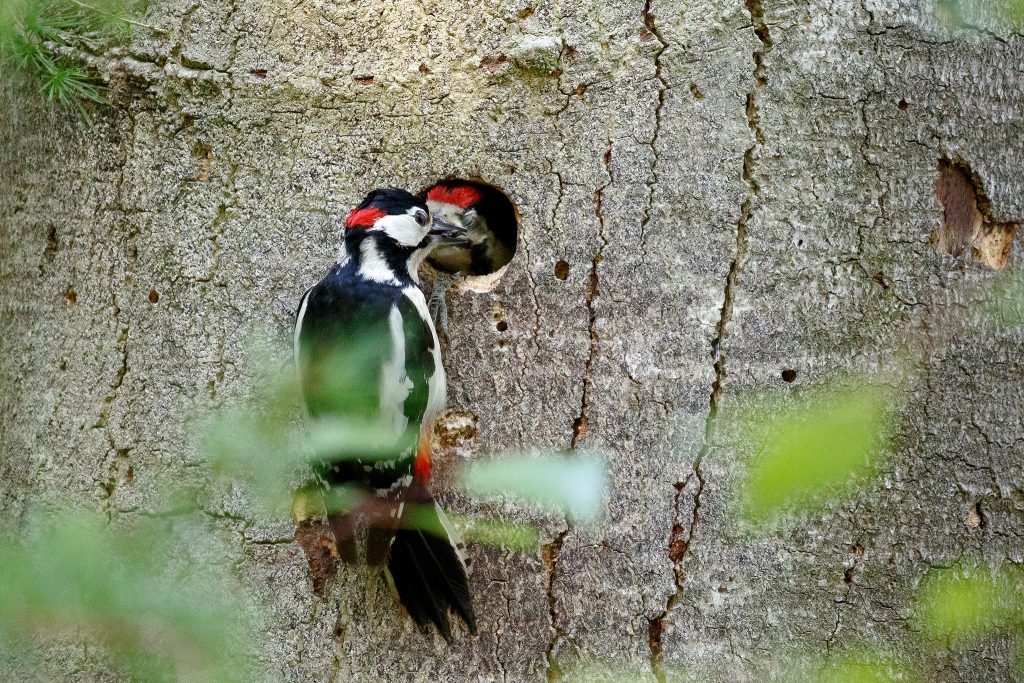
What do baby woodpeckers normally eat?
Since baby woodpeckers need plenty of protein to grow strong, the parents usually bring them insects to eat. For the first two weeks of their lives, one of their parents will go feed on insects, and then regurgitate them into the chicks’ mouths – much as you’d expect from other bird species.
Then, once they’re starting to develop feathers, both parents will go hunting. When the parents come home, they’ll both regurgitate feed into their mouths – such as part-digested insects – as they’re unable to peck and feed for themselves.
After about 30 days from being born, baby woodpeckers are typically strong enough to leave their nests – where they’ll fly off on their own and start sampling the wide, wonderful diet listed above!
Where do woodpeckers find their food?
Woodpeckers are not picky about where they find their food, though most of it comes from the trees into which they drill. Trees host most of their favorites, from nuts and sap to insects.
Woodpeckers will also happily eat from bird feeders as long as they have been adequately placed in your garden. Woodpeckers are very shy and not keen on sharing, so keep their feeders away from other bird visitors. As explored, filling a woodpecker feeder with fresh suet is a great way to keep these birds coming back for more.
Woodpeckers also frequently eat from berry bushes, tree stumps, and even the sides of houses. Many people find woodpeckers munching on the tops of their homes, and that can be because there’s something sweet inside that they need to get to – they don’t ever intend to cause damage for the sake of it.
Relative to other birds, woodpeckers are highly intelligent and will find food when and where they need to. They are very independent and typically know the best sources – and if not, those species that choose not to migrate will simply store nuts and seeds in the hollows of trees for safe keeping.
Despite the woodpecker’s relatively self-sufficient nature, every little bit helps – and a well-stocked feeder in your garden will help to prepare these birds for the colder months of the year still to come.
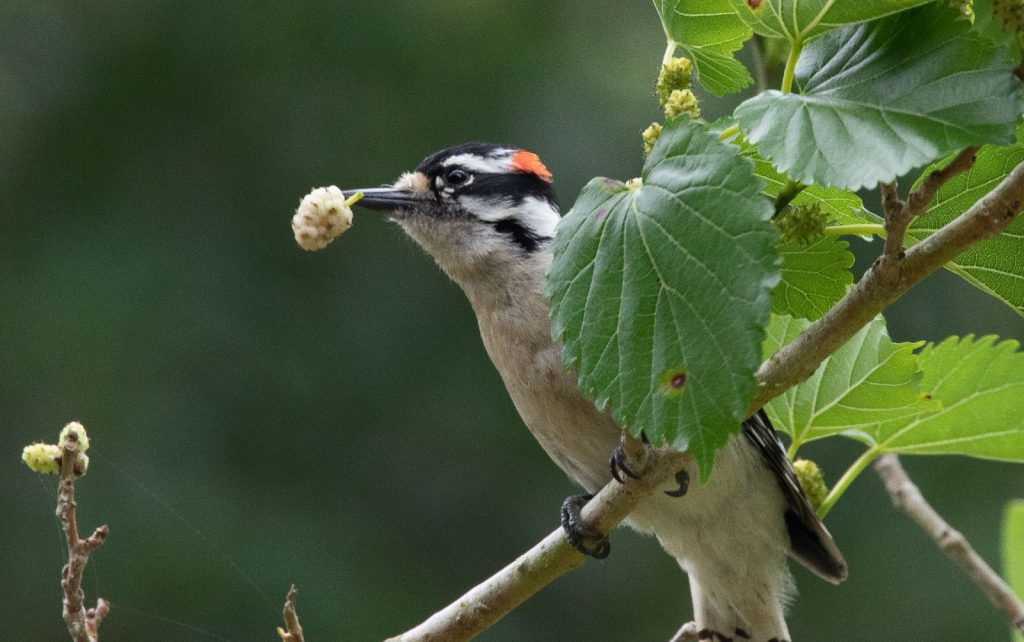
How do woodpeckers eat?
Woodpeckers make holes in wood to get to their main source of food, insects – but they need to use their long tongues to get deep into the caches they drill.
Some woodpeckers, such as northern flickers, have especially sticky tongues, ideal for lapping up various small insects at once – such as ants, which travel in groups.
Some species – such as red-bellied woodpeckers – have barbed tongues that impale insects while they eat, ensuring they grab larger quantities in each mouthful. All woodpeckers are omnivorous, meaning regardless of which species prefer a fruit-based diet, most will be well-equipped to eat the food listed in this guide.
How much do woodpeckers eat every day?
Although we do not know how much woodpeckers eat per day on average, we do know that different species of woodpecker have varied preferences and vary in terms of the quantities they need to consume.
For example, green woodpeckers are more likely than any other species to eat ants, and they have been known to eat up to 2,000 of the insects each day – and will top up on other species and their larvae, too.
What we know for certain is that woodpeckers are highly food-motivated, second only to the tireless hummingbird. They will spend hours pecking at the same spot, sometimes even days on end if they know they can get into a tasty clutch of bugs, fruit, or nuts.
When nesting, they will eat even more to feed their young – which explains why woodpeckers choose to set up nests in areas close to abundant wild food.
Do woodpeckers eat in the winter?
Woodpeckers typically eat normally throughout the winter, and although they tend to prepare their homes by filling trees with acorns, it is not because they plan on hibernating.
In fact, it is simply because they know that their primary food sources will be scarce in the colder months.
The cold brings snow and cool air, but it also takes away most insects, nectar-filled hummingbird feeders, and fruits, all of which woodpeckers love and need.
Without their favorite foods, woodpeckers make do with what they can find. That usually consists of acorns, certain berries, and insect larvae – a tasty substitute for adult varieties.
And, of course, for those who are kind enough to leave it out, woodpeckers will happily eat all of the suet they can in the winter – all the more reason to prepare your own feeder and table.
Not all woodpeckers eat to beat the cold, as many species choose to migrate instead. Woodpeckers that migrate include red-naped sapsuckers, yellow-bellies, and northern flickers. This behavior is in the minority, with some species choosing to migrate for mating purposes, not purely to beat the cold.
Do woodpeckers need to drink water?
Woodpeckers need water to survive, but they do not have to constantly stop by streams and birdbaths to get the hydration they need – they get plenty of liquid from their food sources.
For example, berries and other fruit are full of liquid, providing woodpeckers with a double hit of food and drink. Woodpeckers will also get plenty of hydration from hummingbird feeders if you have any set up around the garden.
That said, it’s also good to have a separate source of water for woodpeckers to drink from when temperatures are high. Simply set up a small birdbath in your garden with fresh, clean water.
Woodpeckers are shy little creatures, and they do not like to share – so be sure to fill a separate dish, away from other birds, around two inches deep. Keep it in a sheltered area, ideally with plenty of branches around, and away from frequent noise. Keep it clean and warm, too – and refill daily.
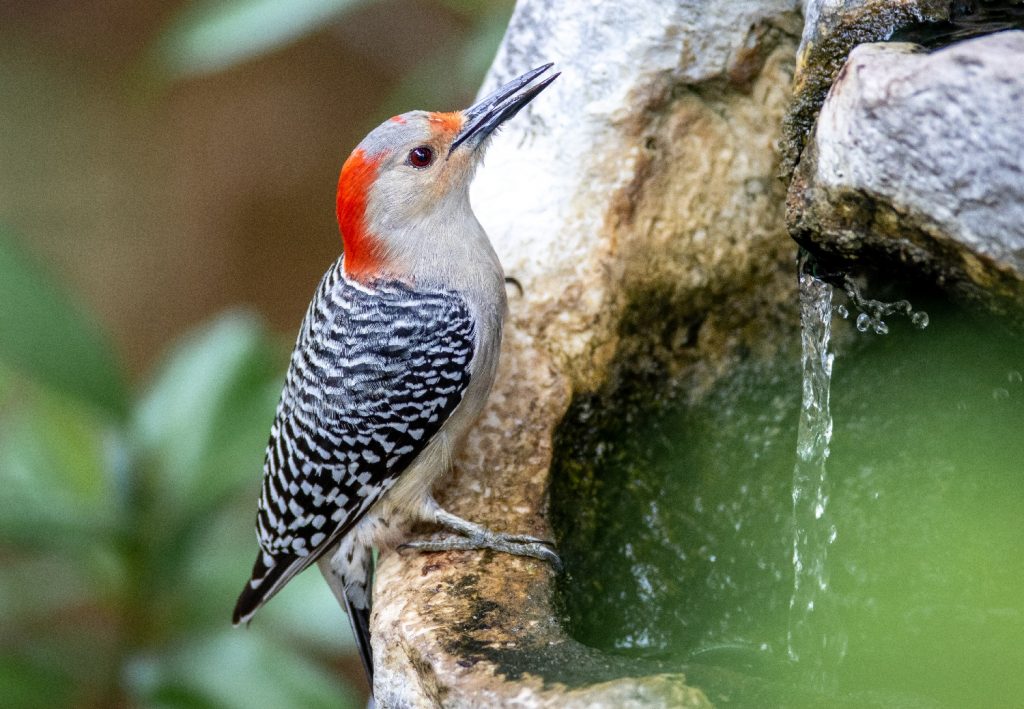
How to provide food for the woodpeckers in your garden
Choosing a healthy mix of fruit, nuts, seeds, and suet will help keep the woodpeckers visiting your garden well-fed. Leave any food you intend for woodpeckers in quiet, sheltered areas. The more branches there are for the woodpeckers to perch on, the better.
Although it’s not recommended that you leave food too high up in a tree, using a stick to place some items a little higher up is a great way of helping nature’s percussionists out!
Another great way to ensure woodpeckers are fed is by placing food in a specialist woodpecker feeder. These are often designed to keep other animals out, with some models even coated in suet to attract woodpeckers easier.
Woodpeckers also require a perch to stand on while they peck at food – and most specialized woodpecker feeders should have these poles already built-in.
Does anything eat woodpeckers?
Animals such as cats, foxes, coyotes, owls, snakes, and even hawks are all known to eat woodpeckers – they are the perfect prey when they are young and nest-bound. Many woodpecker parents leave their nests unattended – meaning predators will take opportunities to strike.
Some woodpeckers can also be killed accidentally, or eaten by opportunistic predators without any kind of ‘game plan’. Generally, these birds camouflage well, but their loud drilling can sometimes give them away.
Should I feed woodpeckers in my yard?
There is certainly no harm in feeding your local woodpeckers. While these birds are perfectly sufficient at finding their own sustenance, providing a little extra suet and occasional nutty snacks will help keep them well-fed as the colder months draw in.
Be sure to set up a woodpecker feeding table or pole far from other feeding spots in your yard – and as close to the edge of your garden as possible. These birds are magnificent pest controllers – and will add a wonderful splash of character to your wild yard! There’s no need to worry about woodpeckers eating your trees – there are far too many other tasty opportunities out there.
